Chicago
![]()
The title of this article is ambiguous. For other meanings, see Chicago (disambiguation).
Chicago (less commonly in German also Chikago, pronunciation: [ʃɪˈkɑːgoʊ]; ![]() ) is a city on the southwestern shore of Lake Michigan in the state of Illinois in the United States of America. With a population of 2,716,450, it is the third largest city in the United States. The agglomeration is home to 8.7 million people, and the Chicago metropolitan area to 9.7 million (2007).
) is a city on the southwestern shore of Lake Michigan in the state of Illinois in the United States of America. With a population of 2,716,450, it is the third largest city in the United States. The agglomeration is home to 8.7 million people, and the Chicago metropolitan area to 9.7 million (2007).
Chicago has been an important commercial city in the United States since the mid-19th century. This function is aided by its status as a railroad hub and its location at the mouth of the Illinois Waterway. The city lies on important railroads connecting the east and west coasts and is linked to the Atlantic Ocean and to New York City by the Great Lakes and the Saint Lawrence Seaway or Erie Canal. The Illinois Waterway connects to the Gulf of Mexico via the Mississippi River.
Chicago is home to the Chicago Mercantile Exchange, the largest commodity futures exchange in the United States, and the Chicago Board of Trade, the largest commodity, futures and options exchange in the United States. It is also home to the largest regional stock exchange in the United States, the Chicago Stock Exchange.
The Chicago metropolitan region generated $651.2 billion in economic output in 2016. In a 2014 study, Chicago ranked 9th among the world's strongest metropolitan areas and 3rd within the United States.
Geography
Geographical position
Chicago is located in northeastern Illinois. According to United States Census Bureau data, the city has an area of 606.1 square kilometers. Waters cover 2.94 percent of that (17.8 square kilometers). Chicago is where the Chicago River once emptied into Lake Michigan, one of the five Great Lakes of North America. However, the direction of flow of the Chicago River was reversed in 1900 so that it no longer empties into Lake Michigan, which is used for drinking water, but is instead diverted via the Chicago Sanitary and Ship Canal into the Illinois River and ultimately the Mississippi River. More than 20 drawbridges, such as the State Street Bridge and the Canal Street Railroad Bridge, span the river.
The Chicago metropolitan region covers 28,163 square miles and spans dozens of suburbs in nine different counties that are intertwined with the Chicago metropolitan area. These are Cook, DuPage, Kane, Kendall, Lake, McHenry, and Will counties in Illinois, Lake County in Indiana, and Kenosha County in Wisconsin. Because the suburbs are politically independent, no tax dollars flow from these enclaves to fund central metropolitan infrastructure. This is especially important in the case of schools because much of their funding comes from local property taxes, with statewide per-pupil grants as a supplement.
The Chicago metropolitan region was the inspiration for the development of renowned urban geographer Ernest Burgess' model of urban zones around a Central Business District (CBD). The core of the CBD is the so-called Loop; this includes a neighborhood enclosed by the Chicago "L" tracks (the Community Area 32) and the adjacent areas.
City breakdown
Since the 1960 expansion of the city to accommodate the generous expansion of O'Hare Airport, the City of Chicago has been divided into 77 Community Areas.
The center of the city is formed by the Chicago Loop (32), Near North Side (8) and Near South Side (33) neighborhoods, which are separated by the Chicago River. The Loop is home to the AON Center, Willis Tower, and City Hall, among other buildings. The portion of Near North Side that is heavily built up with high-rises is essentially bounded by North Lake Shore Drive the North LaSalle Street. The tallest building on the Near North Side is the John Hancock Center. The world-renowned inner skyscraper area covers approximately six square miles, or only about one percent of Chicago's urban area.
| 01 | Rogers Park | 21 | Avondale | 41 | Hyde Park | 61 | New City |
| 02 | West Ridge | 22 | Logan Square | 42 | Woodlawn | 62 | West Elsdon |
| 03 | Uptown | 23 | Humboldt Park | 43 | South Shore | 63 | Gage Park |
| 04 | Lincoln Square | 24 | West Town | 44 | Chatham | 64 | Clearing |
| 05 | North Center | 25 | Austin | 45 | Avalon Park | 65 | West Lawn |
| 06 | Lakeview | 26 | West Garfield Park | 46 | South Chicago | 66 | Chicago Lawn |
| 07 | Lincoln Park | 27 | East Garfield Park | 47 | Burnside | 67 | West Englewood |
| 08 | Near North Side | 28 | Near West Side | 48 | Calumet Heights | 68 | Englewood |
| 09 | Edison Park | 29 | North Lawndale | 49 | Roseland | 69 | Greater Grand Crossing |
| 10 | Norwood Park | 30 | South Lawndale | 50 | Pullman | 70 | Ashburn |
| 11 | Jefferson Park | 31 | Lower West Side | 51 | South Deering | 71 | Auburn Gresham |
| 12 | Forest Glen | 32 | Chicago Loop | 52 | east side | 72 | Beverly |
| 13 | North Park | 33 | Near South Side | 53 | West Pullman | 73 | Washington Heights |
| 14 | Albany Park | 34 | Armour Square | 54 | Riverdale | 74 | Mount Greenwood |
| 15 | Portage Park | 35 | Douglas | 55 | Hegewisch | 75 | Morgan Park |
| 16 | Irving Park | 36 | Oakland | 56 | Garfield Ridge | 76 | O'Hare |
| 17 | Dunning | 37 | Fuller Park | 57 | Archer Heights | 77 | Edgewater |
| 18 | Montclare | 38 | Grand Boulevard | 58 | Brighton Park | ||
| 19 | Belmont Cragin | 39 | Kenwood | 59 | McKinley Park | ||
| 20 | Hermosa | 40 | Washington Park | 60 | Bridgeport |
Climate
The climate in Chicago is continental (Dfa) with hot, humid summers and cold, snowy winters. The average annual temperature is 10.5 degrees Celsius, and the average annual precipitation is 910 millimeters. The coldest month is January with an average of -3.3 degrees Celsius, the warmest month is July with an average of 24.3 degrees Celsius.
The most precipitation falls in August with an average of 107 millimeters, the least in February with an average of 35 millimeters. Overall, the weather in Chicago is considered changeable. Especially in spring and autumn there is often a strong wind, and the humidity is high all year round.
The highest temperature was officially recorded on July 24, 1934 at the weather station at Midway Airport at 41 degrees Celsius, and the lowest was recorded on January 20, 1985 during the North American cold snap at the University of Chicago weather station (Rosenwald Hall, 58th St. and University Ave.) at -33 degrees Celsius. The most precipitation fell on Aug. 14, 1987, at the weather station at O'Hare Airport with 165 millimeters. The snowiest winter was 1978/79 (Nov. 27-March 4) with 2278 millimeters of precipitation.
| Chicago | ||||||||||||||||||||||||||||||||||||||||||||||||
| Climate diagram | ||||||||||||||||||||||||||||||||||||||||||||||||
| ||||||||||||||||||||||||||||||||||||||||||||||||
| Monthly average temperatures and precipitation for Chicago
Source: WMO: World Weather Information Service | ||||||||||||||||||||||||||||||||||||||||||||||||||||||||||||||||||||||||||||||||||||||||||||||||||||||||||||||||||||||||||||||||||||||||||||||||||||||||||||||||||||||||||||||||||||||||||||||||
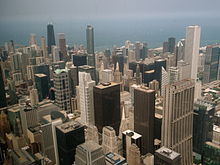
A part of the skyline seen from the Willis Tower

Chicago: the Community Areas
History
Early history
The region of the present city was inhabited by Algonkin tribes, such as the Mascouten and the Miami. They had been driven westward by the Iroquois Wars of the 16th and 17th centuries, especially the Beaver Wars. By 1700, however, they had returned. The Miami included six groups around this time, the Atchatchakangouen (the Miami proper), Kilatika, Mengakonkia, Pepikokia, Piankashaw, and Wea, though a hundred years later only the Miami, Piankashaw, and Wea remained. By 1720 they were living mostly in Indiana. From the Miami language comes the term shikaakwa (wild onion).
They traded with their neighbors, the Potawatomi to the east, the Fox to the north, and the Illinois to the southwest, the latter having separated from the Miami shortly before the arrival of the first Europeans. They dominated Illinois and thus the area of what later became Chicago. Of the numerous villages registered by the first French in 1673, only Cahokia, Kaskaskia, Peoria, Michigamea, Moingwena, and Tamaroa survived the epidemics that swept over them. At the same time, they left the Chicago area southwestward. In 1673 they numbered 12,000, but by 1736 they numbered only 2,500. In 1725 "Chicago," a Michigamea-Illinois chief, visited Paris - yet the name of the town does not come from him, for that place name existed as early as 1673. In 1800 the Illinois numbered only 100, and in 1833 the last family left the state. Jean Baptiste Ducoigne, a Kaskaskia Illinois chief and friend of President Thomas Jefferson, supported the United States in its rebellion against Great Britain and in the War of 1812.
From trading post to town (1673-1837)
In 1673, French explorers Jacques Marquette and Louis Joliet navigated the area of present-day Chicago, which was called Checagou by the Native American population living there. In the 1770s, Jean Baptiste Point du Sable - son of a Québec merchant and a black slave - established a trading post at the exchange point of the local Miami, Fox, Sac and Potawatomi Indian tribes. "The first white man to settle here was a black man," they are quoted as saying.
Thanks to its convenient location on the water transportation routes of Lake Michigan, one of the Great Lakes, and the Chicago River, the trading post grew visibly in importance until the beginning of the 19th century. When Illinois joined the United States in 1818 and was therefore to be better served by transportation, Chicago therefore quickly gained a reputation as the "Gateway to the West" after the construction of the East-West railroad. It was now the most important trading center for raw materials and agricultural products far and wide.
Timber came by ship from the north and was resold locally or transported on by rail, and food was brought by farmers to the markets, from where it could in turn be transferred to ships or trains and shipped. Tools and other materials which (for the time being) were not produced locally, or were produced in insufficient quantities, again came from the East. Thus the trading post became a village. On August 12, 1833, Chicago was officially incorporated, and just four years later, on March 4, 1837, its 4200 inhabitants were elevated to the status of a city.
Rapid expansion (1837-1885)
More and more people moved to the city and the already pronounced trade was further driven, attracting even more immigrants. From a population of only 100 in 1830, Chicago's population rose to 100,000 by 1860, and land prices rose rapidly. When the construction of the "Illinois and Michigan Canal," begun in 1836, between the Chicago River and the Illinois River flowing into the Mississippi was completed in 1848, there was another extremely attractive transportation route. Six states south along the Mississippi River and three north and regions along the Missouri River, which flowed into the Mississippi, were now additionally served by a wide waterway.
Also in 1848, the first railroad was opened that also served Chicago: the Galena and Chicago Union Railroad. Since the completion of the Chicago Sanitary Canals in 1900, the Chicago River no longer flows into Lake Michigan, but through the Illinois and Michigan Canal and subsequently the Illinois River into the Mississippi River.
In 1850, Chicago already had 30,000 inhabitants, and there was no end in sight to the influx - the conditions at the United States' transportation hub were too favorable. In 1855, the Beer Riot occurred. In this uprising, German settlers fought for their right to serve beer on Sundays.
Beginning in 1856, the ground elevation of all of downtown Chicago was raised piecemeal to improve the sewer system after various epidemics. The raising lasted about 20 years, with elevations ranging from less than a meter to 2.5 meters.
Between October 8 and October 10, 1871, the Great Chicago Fire raged, destroying most of the city. After the fire, 125 bodies were recovered. Estimates ultimately came to 300 dead and 18,000 homes destroyed. About 100,000 people were left homeless. Rapid reconstruction incorporated improved fire codes. Architects such as Louis Sullivan and later Frank Lloyd Wright came to the city, which now served as an experimental ground for urban innovation. In 1880, the "reborn" city already had 500,000 inhabitants.
Between 1880 and 1890, the population doubled and Chicago now had over one million residents. Although land prices in the inner city had already experienced extreme increases time and again since the city's designation, this time they entered a new price dimension. In 1880, a square meter cost 130 US dollars, but by 1890 the price had increased sevenfold to almost 900 US dollars per square meter. In order to be profitable, property owners began to maximize the use of their floor space, which meant building higher. This became possible thanks to new inventions such as electric elevators, more fire-resistant building materials, but above all the use of steel skeletons in building construction.
The Home Insurance Building, built in 1885 and demolished in 1931, was the first structure to incorporate the new technical achievements and, with its original ten floors and 42-meter height, is considered the world's first modern skyscraper. Built in 1889 by Dankmar Adler and Louis Sullivan, the Auditorium Building also featured - in addition to its near-perfect acoustics - air conditioning as a novelty. The Reliance Building was built between 1890 and 1894 and is considered the forerunner of the glass curtain wall construction that would later define the "International Style." It is considered a masterpiece of the First Chicago School.
Industrial Great Power (1885-1918)
On May 1, 1886, Chicago's labor unions organized a strike to reduce work hours from twelve to eight hours a day. When police cracked down on May 3, and strikers were killed, a riot ensued that went down in history as the Haymarket Riot; since then, it has been commemorated annually on May 1, Labor Day. The end of the 19th century was not a quiet period in other respects either. Corruption experienced its first heyday. Many of the city's politicians were for sale. About a quarter of the aldermen owned saloons and were considered boodlers ("greased"). Hempstead Washburne, mayor from 1891 to 1893, campaigned for re-election by saying it was "wiser to vote for a man who has already stolen enough than for a new one." Election fraud was also commonplace. Washburne did not succeed in his re-election in any case.
From May 1 to October 30, 1893, the World's Columbian Exposition, known as the World's Columbian Exposition, was held in Chicago. It had a great influence on the development of art and architecture of the time. The event shaped Chicago's self-perception and strengthened the population's optimistic view of industrial progress, especially since Chicago was able to win the race against the unloved New York City.
In 1890, one million people lived in the city, and by 1910 this number had doubled to two million. By 1900, the city had 1.7 million residents, including many German, Irish, and Eastern European immigrants. By this time, Chicago's reputation as a place of seemingly unlimited opportunity was solidifying, with numerous jobs available for anyone willing to work. Most attracted to this promise were black residents from the southern states. Between 50,000 and 75,000 African Americans moved to the city in the period 1916 to 1919 alone.
During this time Chicago also became known as the hog butcher for the world. The city was the main transshipment point for the agricultural products of the Midwest, in addition to grain and wood, this was primarily livestock. Within a few decades, the slaughterhouses at the so-called Union Stock Yards had developed into the most important in the world. Especially the assembly line production in meat processing was worldwide trend-setting. At the turn of the century, up to 12 million animals were slaughtered annually at the Stock Yards and approximately 82 percent of American meat was processed. The poor working conditions and lack of hygiene became known, among other things, through Upton Sinclair's novel The Jungle.
Long hours, low pay and inhumane working conditions, but above all the traditions of self-organization brought by immigrants, led to Chicago becoming the cradle of the American trade union movement. By 1900, most workers had organized in the American Federation of Labor. The Industrial Workers of the World (IWW), a revolutionary union that still exists today, was also founded here in 1905. The play St. Joan of the Slaughterhouses by Bertolt Brecht is set in Chicago in the late 1920s and focuses on the poor working conditions and the workers' struggle against them. When, on July 27, 1919, a white police officer refused to arrest an accused white man after stoning a black youth swimming in the lake, a six-day riot ensued, leaving 38 dead.
City of Jazz and Gangsters (1918-1945)
From 1922 onwards, Chicago became a jazz metropolis. Greats such as Louis Armstrong, Earl Hines and Jelly Roll Morton enlivened the "black clubs" and shaped Chicago jazz. In that year, the Tin Pan Alley composer Fred Fisher, who had emigrated from Cologne to Chicago, created Chicago (That Toddling Town), a much-covered homage to the city.
It wasn't just jazz that came to Chicago through African Americans: the city also became a center of black organizations - both PUSH (People United to Save Humanity), founded by the Reverend Jesse Jackson, and the more militant Nation of Islam (actually The Lost-Found Nation of Islam, also known as Black Muslims), started by Elijah Muhammad in 1930, are headquartered on Chicago's South Side.
During the Roaring Twenties, criminal syndicates under ruthless gangster bosses like Bugs Moran, Johnny Torrio and Al Capone took advantage of Prohibition and sold illegally manufactured alcohol. Firefights between police and gangsters were not as much the order of the day as many movies would have you believe, but the Mafia-like system worked.
In 1933 and 1934 a World's Fair was held for the second time in Chicago under the motto A Century of Progress, to which the German airship LZ 127 made a visiting trip in 1933.
On October 5, 1937, U.S. President Franklin D. Roosevelt gave his "Quarantine Speech" in the city on the occasion of the dedication of the Outer Link Bridge on Lake Shore Drive, which caused a sensation worldwide and was the first time that the USA claimed to have a say in the future political order of the world.
In 1942, physicist Enrico Fermi at the University of Chicago achieved the first controlled nuclear chain reaction as part of the Manhattan Project, whose goal was to build nuclear weapons.
Downturn and recovery (From 1945 to the end of the 20th century)
The population reached its maximum in 1950 (3.62 million inhabitants); thereafter it declined steadily by a total of about 840,000 inhabitants until 1990 due to the (mostly white) middle class migrating to the suburbs. Since the beginning of the 1990s, the population has recovered again.
From 1955 to 1976, Richard J. Daley played a major role in shaping Chicago politics as mayor; he also played an important role in the Democratic Party, for example in supporting the presidential candidacies of John F. Kennedy in 1960 and Hubert Humphrey in 1968. His time in office included the brutal crackdown on anti-war demonstrators in 1968. During the Democratic National Convention in August 1968, there were violent riots against the Vietnam War. In 1969, the Chicago Seven were indicted for this.
In 1979 Jane Byrne became Chicago's first female mayor and in 1983 Harold Washington became its first black mayor. The challenger to Washington, a Democrat, in the 1983 mayoral election was Republican Bernard Epton, who was supported by many white Democrats and grassroots organizations. Epton received 90 percent of all votes in precincts with predominantly white populations and only three percent in those with predominantly black populations. For Washington, the numbers were reversed. Overall, Harold Washington won by a four percentage point margin. He won re-election safely in the spring of 1987. He governed Chicago until his death in November 1987.
Centre of the region (21st century)
Since the beginning of the 21st century, the city's status as the cultural and economic center of the region has been undisputed. However, the city also faces a high number of gunshot victims. In 2016, there were about 4300 people shot, of whom about 760 died.
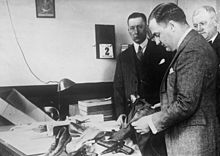
The police with guns of a shot gangster, 1931
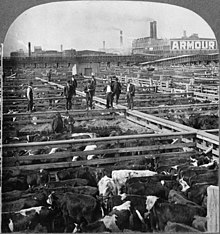
Cattle waiting to be slaughtered at the Union Stock Yards (1909)
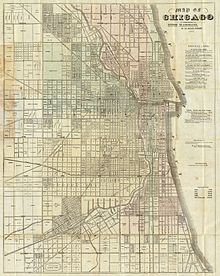
Chicago 1857
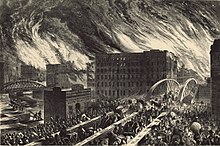
Great fire of 1871

Postcard view of State Street circa 1907
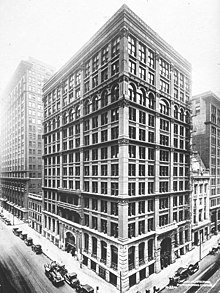
The Home Insurance Building from 1885 (here with an addition from 1890) with 42 meters (10 floors) is considered the first skyscraper in the world.

View from the John Hancock Center to the north
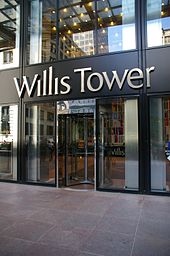
Main entrance of the Willis Tower
Questions and Answers
Q: What is the population of Chicago?
A: As of 2018, the population of Chicago is 2,705,994.
Q: What is the largest metropolitan area in the United States?
A: The Chicago metropolitan area has 10 million people and it has the third largest population in the United States.
Q: When did Chicago become a city?
A: Chicago became a city in 1837.
Q: What caused major destruction to Chicago in 1871?
A: The Great Chicago Fire of 1871 destroyed many square miles and made more than 100,000 people homeless.
Q: How did tourism change for New York City and Chicago from 2017-2018?
A: In 2018, 58 million people visited Chicago while 65 million people visited New York City. This means that New York City had 7 million more visitors than Chicago in 2018.
Q: What are some landmarks located in the city of Chicago?
A: Some landmarks located in the city ofChicago include Millennium Park, Navy Pier, Magnificent Mile, Art Institute ofChicago, Museum Campus, Willis (Sears) Tower, Grant Park,Chicago Riverwalk, Museum of Science and Industry and Lincoln Park Zoo.
Q: What professional sports teams are based out ofChicago?
A: There are professional sports teams based outofChicago that compete within all four major professional leagues including two Major League Baseball teams.
Search within the encyclopedia